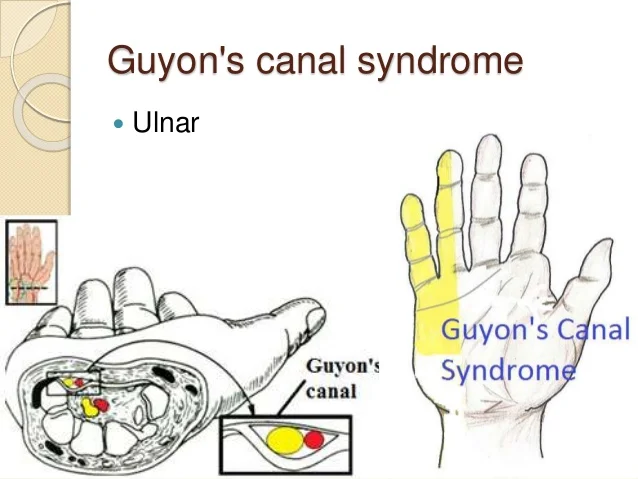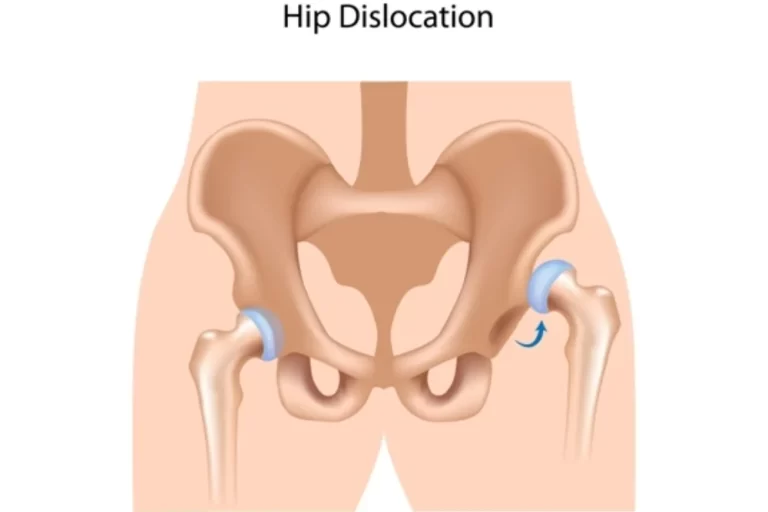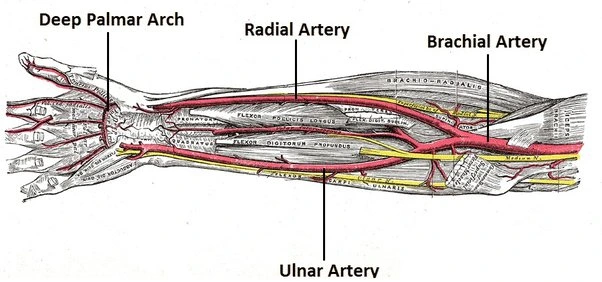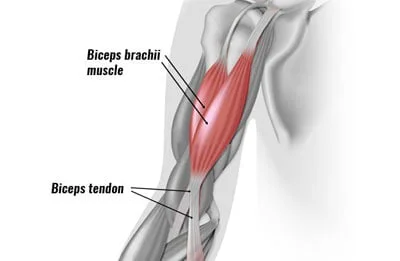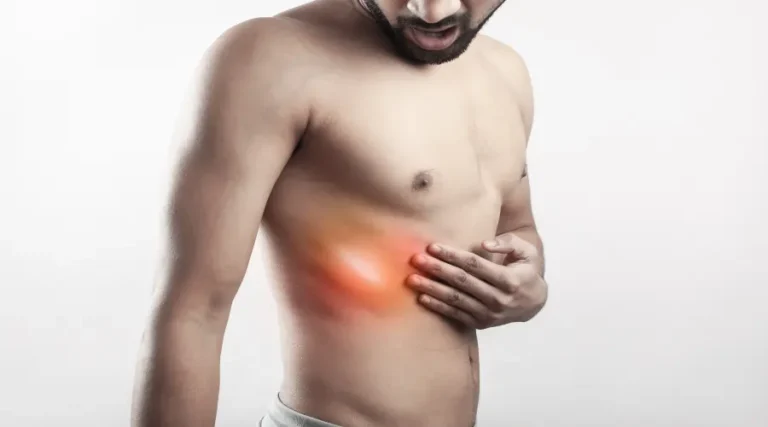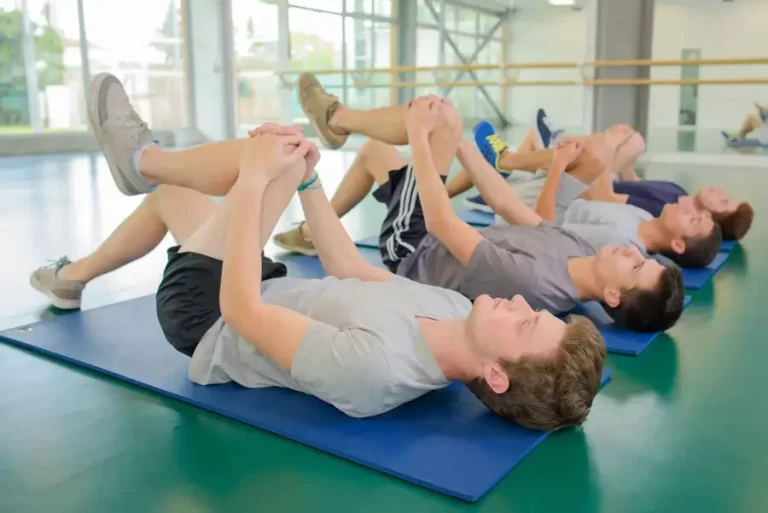Guyon Canal Syndrome (Ulnar tunnel syndrome)
What is a Guyon Canal Syndrome?
Guyon’s Canal Syndrome, also known as Ulnar Tunnel Syndrome, is a condition caused by compression of the ulnar nerve as it passes through Guyon’s canal in the wrist. It can result from repetitive wrist motions, prolonged pressure, or trauma. Symptoms include numbness, tingling, weakness, and pain in the ring and little fingers. Diagnosis is based on clinical evaluation and nerve conduction studies. Treatment ranges from activity modification and splinting to surgical decompression in severe cases.
Depending on where the nerve compression occurred, the clinical appearance may be entirely sensory, solely motor, or both. One of the primary major nerves in the hand, the ulnar nerve goes beneath the forearm muscles, down the neck via the medial epicondyle, and ends up next to the palm on the little finger.
Clinically Relevant Anatomy:
The brachial plexus’s medial cord (C8-T1) gives rise to the ulnar nerve, which subsequently runs via the axilla and the anterior compartment of the arm before piercing the intramuscular septum or mostly traveling in the posterior compartment. It then enters the cubital fossa posterior to the humerus’ medial epicondyle. After that, the nerve travels between the main flexor digitorum profundus and the primary flexor carpi ulnaris muscles.
Before entering Guyon’s canal, the primary ulnar nerve branches off dorsally 8.3 cm proximal to the pisiform bone. The main Guyon Canal runs from the pisiform bone’s proximal border to the hamate’s hook, which is located farther away. From the distal forearm to the major hand, the ulnar nerve and artery pass through the Guyon canal.
The Guyon Canal’s borders are as follows:
- Roof: hypothenar connective tissue or palmar carpal ligament.
- Floor: flexor digitorum profundus tendons, metacarpal ligament, transverse carpal ligament, isogametes ligament, or opponens digit minimi
- Medial wall: pisiform, abductor digit mini, and principally flexor carpi ulnaris tendon.
- Lateral wall: the flexor tendons, transverse carpal ligament, or hook of the hamate.
Epidemiology:
Guyon canal syndrome is frequently observed as a result of recurrent trauma and ganglion cysts. However, due to a paucity of research, the incidence of Ulnar tunnel syndrome in the general population has not yet been precisely determined.
Pathophysiology:
Zone 1: proximal to the split of motor and sensory
- region of the main trunk’s distalmost ulnar nerve prior to its division into its deep motor or superficial sensory divisions Ganglion cysts and hook of hamate fractures, malunions, and nonunions are among the etiologies.
- Both motor and sensory symptoms are caused by damage to the ulnar nerve in the Zone 1 major Guyon canal.
Zone 2 (most commonly affected): zone 3 radially, or distal to the motor and sensory bifurcation.
- If impacted, it only causes primary motor symptoms (such as weakness) and corresponds to the ulnar nerve’s main deep terminal motor branch.
- Ganglion cysts and hook of hamate fractures, malunions, and nonunions are among the etiologies.
- All of the interosseous muscles, the fourth or fifth lumbricals, the hypothenar muscles (opponens digit mini, abductor digit mini, flexor digit mini brevis), and the adductor pollicis muscle are innervated by this primary deep branch of the ulnar nerve.
Zone 3: ulnar to zone 2 or distal to the motor/sensory bifurcation
- In this region, the ulnar nerve’s superficial sensory terminal branch is compressed, resulting in only sensory sensations like burning and tingling or numbness.
- The main ulnar artery aneurysm and/or thrombosis are among the causes.
Causes of Guyon Canal Syndrome:
- Vascular insufficiency, inflammation, trauma, and compression can all cause damage to the distal ulnar nerve.
- The most frequent cause of Guyon Canal Syndrome is ganglion cysts.
- Cancers
- The hypertrophic muscle of normal anatomy and an odd placement are examples of anatomical abnormalities.
- Aneurysms and ulnar artery thrombosis (such as Hypothenar Hammer Syndrome)
- Dislocations and fractures (such as the hook of Hamate’s displacement or fracture)
- A recurring micro injury, such cyclists’ hypothenars being repeatedly traumatized by the handlebar
- Anatomical alterations in the ulnar tunnel caused by Carpel tunnel syndrome may result in functional problems.
- Iatrogenic.
Symptoms of Guyon Canal Syndrome:
Guyon Canal syndrome symptoms can range in intensity and include:
- Numbness or tingling: The most typical sign is to feel as though your little and ring fingers are numb or tingly. The palm side of the hand may also experience this sensation.
- Weakness: There may be weakness in the hand, particularly in the muscles that govern the little and ring fingers. Tasks requiring fine motor skills, such typing, writing, or holding things, may become challenging as a result.
- Loss of dexterity: The affected hand may become less coordinated and dexterous. It may become difficult to perform tasks that require precise finger movements, such buttoning clothing or handling small things.
- Pain or discomfort: Some people may have wrist or hand pain or discomfort. Activities involving wrist movement or pressure on the affected area may exacerbate the pain, which can be severe, throbbing, or agonizing in character.
- Hand clumsiness: People with Guyon Canal syndrome may find it difficult to do tasks requiring fine motor skills because of the hand’s weakness and impaired sensation. This can lead to a perception of clumsiness or more frequent dropping of objects.
- It’s crucial to remember that repetitive wrist motions or extended pressure on the affected area may exacerbate or make symptoms more obvious.
- Thumb adduction, ring or small finger digital flexion, and discomfort or paresthesias in the ulnar 1-1/2 digits
Risk factor of Guyon Canal Syndrome:
- Its wrist has already sustained an injury.
- uses the hands to carry out repetitive tasks, including typing
- Does engaging in sports or activities that strain the wrist
- makes use of vibrating instruments.
Diagnosis:
Physical examination:
- Examining and sense
- Loss of intrinsics bending the MCPs or lengthening the IP joints results in clawing of the ring or little fingers.
Neurovascular examination:
- Paralysis of the primary intrinsic muscles (adductor pollicis, deep head FPB, interossei, or lumbricals 3 or 4) is the outcome of ulnar nerve palsy.
- reduced grip strength and MP joint flexion power.
- Thumb adduction loss due to weak pinch.
Allen test:
- mostly aids in the diagnosis of ulnar artery thrombosis.
Froment sign:
- When trying to grip a piece of paper, IP flexion makes up for the loss of thumb adduction.
- The adductor pollicis (ulnar n.) makes up for the loss of MCP flexion or adduction, and the FPL (AIN) compensates for this.
Jeane’s sign:
- The primary loss of IP extension or thumb adduction by the adductor pollicis (ulna n.) is compensated for by a compensatory thumb MCP hyperextension or thumb adduction by EPL (radial n.).
- The little finger is the primary abduction posture.
Imaging Studies:
- A computed tomography (CT) scan and a hand x-ray can be used to check for fractures, particularly hamate fractures.
- Anatomical changes inside the Guyon canal or structures that cause mechanical compression of the ulnar nerve, such as lipomas, ganglion cysts, and abnormal muscle, can be detected by magnetic resonance imaging of the hand.
- Thrombosis and ulnar artery aneurysms can be assessed by angiography.
- Nerve conduction velocity (NCV) or electromyography (EMG) are used to determine the level of peripheral nerve compromise or to distinguish between main C8-T1 radiculopathy and ulnar nerve entrapment within the Guyon canal at the wrist versus the cubital tunnel at the elbow.
Differential Diagnosis:
- Alcohol-related neuropathy
- Amyotrophic lateral sclerosis
- Brachial plexus abnormalities
- Cervical disc disease
- Cervical spondylosis
- Epicondylitis
- Pancoast tumor
- Thoracic outlet syndrome
- Traumatic peripheral nerve lesions
Treatment of Guyon Canal Syndrome:
The length and intensity of symptoms, as well as the precise etiology identified as the primary cause of the symptoms, will determine whether conservative treatment or primary surgery is chosen. Professional athletes, particularly baseball players, are susceptible to injuries such as hook of hamate fractures, which are primarily caused by acute trauma and recurrent injuries sustained during play. Hand surgeons generally agree that a major isolated hook of the hamate incision should be made in this situation since it has been shown to have low or negligible rates of postoperative complications, allow for a return to play in three to four weeks, or have high patient satisfaction ratings.
General Considerations:
Guyon canal syndrome and major carpal tunnel syndrome are treated similarly. Its range includes surgical decompression and conservative treatment. Splinting or patient instructions are examples of conservative management.
The main focus of the instructions is to prevent recurrent stress or mechanical compression at the Guyon canal. There are numerous ergonomically preferred handlebar positions that cyclists can employ. Because it puts compressive forces on the hand’s major ulnar nerve, repetitive or prolonged wrist extension movements should be avoided.
Wrist splinting may permit fingers to move freely, but it must maintain the wrist in a primary neutral posture. For one to twelve weeks, it is advised to wear a splint at least at night.
An expert panel of medical professionals agreed to use conservative management for mild to moderately severe symptoms with acute to subacute durations up to primarily three months, according to a European Handguide study published in the British Medical Journal. Surgical decompression was preferred for moderate to severe symptoms that persisted for three months or more. Main post-operative exercises may also be part of surgical treatment, particularly for patients who have a decreased range of motion at the joint. Splinting after surgery wasn’t always necessary. Nonetheless, it might be applied to patients who frequently put strain on the affected wrist joint.
Nerve gliding exercises and therapeutic ultrasonography are other possible treatments. Patients who are asymptomatic do not require surgical treatment for hypothenar hammer syndrome, which is a condition that involves ulnar artery thrombosis and an aneurysm. When symptoms are present, however, the primary course of treatment will involve antiplatelet drugs and surgical repair, such as bypass
Techniques:
Local surgical decompression
- release the hypothenar muscle, decompress ganglion cysts, and resect the hamate hook.
- Examine or release all three zones in the main Guyon’s canal as part of the vascular treatment for main ulnar artery thrombosis.
Tendon transfers
- appropriate claw fingers
- The palmaris longus muscle tendons, ECRL, and ECRB are the most often used grafts. To flex the main proximal phalanx, they must pass volar to the transverse metacarpal ligament.
- Use a two-tailed or four-tailed graft to connect to the ring or small fingers’ A2 pulley.
- reestablish power pinch Smith transfer by utilizing the ring finger’s FDS or ECRB.
- reestablish the small finger’s adduction by transferring EDM’s ulnar insertion to the A1 pulley and the small finger’s radial collateral ligament.
Physical Therapy Treatment in Guyon Canal Syndrome
The treatment of Guyon Canal syndrome heavily relies on physical therapy. Relieving symptoms, enhancing hand function, minimizing pain, and stopping the condition’s progression are the objectives of physical therapy treatment for Guyon Canal syndrome. The following are some typical physical therapy techniques that could be used:
Splinting: To relieve pressure on the ulnar nerve and lessen symptoms, use a brace or splint that immobilizes the wrist in a neutral posture. To support the hand and wrist, a physical therapist can provide off-the-shelf or bespoke splints.
Nerve gliding activities: The ulnar nerve can be mobilized and glided inside the Guyon’s canal with the use of certain exercises that require mild and controlled motions of the wrist, fingers, and thumb. These exercises can enhance nerve function, decrease adhesions, and increase neural flexibility.
Exercises to strengthen the hand’s muscles, especially those involved in grip and finger movements, can improve hand function and make up for any weakening caused by Guyon Canal syndrome. Using therapeutic putty, resistance bands, or hand grippers, a physical therapist might recommend specific exercises.
Range of motion exercises: To preserve joint mobility and avoid stiffness or contractures, perform mild stretches and range-of-motion exercises for the thumb, fingers, and wrist.
Ergonomic modifications: The ulnar nerve might be less stressed by evaluating and altering the patient’s job or daily routine to maximize hand and wrist placement. A physical therapist can offer advice on ergonomic best practices, like utilizing ergonomic gear or modifying workstation configuration.
Pain management approaches: To lessen pain and encourage tissue healing, a variety of pain management modalities may be used, such as ultrasound, transcutaneous electrical nerve stimulation (TENS), heat or cold therapy, or manual therapy techniques.
Education and activity modification: It’s critical to inform the patient about the illness, its causes, and coping mechanisms to keep symptoms from getting worse. The physical therapist might offer advice on how to modify certain tasks, such avoiding repetitive wrist motions or applying cushioning when engaging in wrist-pressure-causing activities.
It’s crucial to remember that a person’s symptoms, the severity of their ailment, and how they react to therapy can all affect the exact treatment plan. After conducting a comprehensive evaluation, a physical therapist will create a customized treatment plan based on the patient’s requirements.
Nerve glide exercise :
- Wrist extension
- forearm pronation
- elbow flexion,
- glenohumeral lateral rotation
- ,glenohumeral depression,
- shoulder abduction.
Grip strengthening exercise :
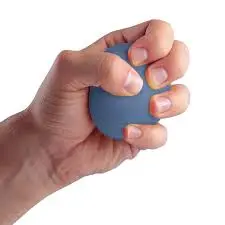
- A tennis or racket ball squeezed.
- Using a towel, stand in a cable row.
- Exercise using Rubber Bands
- Exercises involving tip-to-tip, pad-to-pad, and tip-to-pad using paper and a manual.
Forehead touch exercise:
- Keep your arms at your sides and stand erect.
- Lift one hand and place the palm against your forehead.
- For a few seconds, hold it here, then slowly lower the hand once more.
- Do the exercise again.
Hand curl exercise :
- The ulnar nerve is stretched by that.
- With the elbow straight and the arm held straight in front of the body, stand or sit up straight.
- Curl your fingers and wrists toward your body.
- Then, feel for a wrist stretch by extending the hand away from the body.
- Lastly, lift the hand upward and bend the elbow.
- Do the exercise again.
Ulnar nerve Strengthening Exercise:
- Keep your arms by your sides and stand erect.
- Place your palm on your forehead while raising the affected arm.
- After a few seconds of holding your hand there, carefully lower it.
- A few times a day, repeat the exercise, progressively increasing the amount of repetitions each time.
Other Issues:
- Guyon canal syndrome is a mostly ulnar neuropathy that is somewhat uncommon. In addition to the distinct anatomic changes within the Guyon canal itself, the precise location of nerve compression might determine the range of presenting signs or symptoms, making diagnosis difficult. Although a number of articles offer methods for diagnosing or treating Guyon canal syndrome, thorough guidelines have not yet been firmly established because there aren’t many extensive empirical research. For instance, when an MRI should be recommended for a patient suspected of having Guyon Canal Syndrome.
Enhancing Healthcare Team Outcomes:
- Young people frequently suffer from Guyon Canal Syndrome, a rare neurological condition affecting the hand. The condition is hard to diagnose or has to be treated by an interprofessional team consisting of a therapist, neuro/orthopedic surgeon, neurologist, radiologist, or hand surgeon.
FAQs
What is the Guyon’s Canal release incision?
Between the palmar sensory regions of the median and ulnar nerves, an incision is created from the ulnar to the thenar crease. Furthermore, the transverse carpal ligament can be divided using this method far from the median nerve.
Which workout is ideal for cubital tunnel syndrome?
Without creating too much difficulty, extend your arm in front of you with your palm toward the sky and your elbow fully straight. Turn your fingers slowly and gently downward after gently and slowly curling them into a fist. Bend your elbow gently and softly, then slowly spread your arms wide once more.
What kind of surgery is performed to treat Guyon’s Canal syndrome?
To reach the compressed nerve, surgeons cut across the Guyon’s canal during the treatment. The transverse carpal ligament is then carefully dissected and released. This develops in the canal’s roof, giving the nerve additional room.
What are Guyon Canal’s boundaries?
The Guyon canal’s limitations include the abductor digiti minimi muscle from the ulnar side, the pisiform and pisohamate ligaments, the hook of the hamate bone from the radial side, and the volar and transverse carpal ligaments from the top and bottom, respectively.
What role does Guyon’s Canal play?
The ulnar nerve and artery are protected by the Guyon canal as they pass through it from the distal wrist into the hand. The following structures make it up: The volar carpal ligament, sometimes referred to as the palmar carpal ligament, forms the volar part or roof of the canal.
How does one get to Guyon’s Canal?
The skin incision runs longitudinally in the palm parallel to the ring finger, crosses the proximal wrist crease diagonally, and borders the radial side of the flexor carpi ulnaris (FCU) tendon.
Guyon’s Canal Syndrome NHS: What is it?
A group of symptoms and indicators known as Guyon’s canal syndrome are caused by compression of the ulnar nerve in the Guyon’s canal, sometimes referred to as the ulnar tunnel. It is known as handlebar palsy when it occurs in cyclists as a result of repetitive trauma.
How is Guyon’s Canal syndrome tested for?
In addition to taking your medical history and evaluating your symptoms, your doctor will also do a physical examination. It may be necessary to order imaging tests like CT, MRI, or X-rays. It may be necessary to order certain tests, including doppler ultrasound, to assess ulnar artery blood flow.
Which nerve at Guyon’s Canal is injured?
The distal part of the ulnar nerve is injured when it passes through a small anatomical passageway near the wrist in Guyon Canal Syndrome, a very uncommon peripheral ulnar neuropathy.
How long does it take to recover from Guyon’s Canal syndrome?
Even while every patient recovers differently, you should anticipate that it will take many months to fully recover, and you will likely need to attend our physical therapy or occupational therapy sessions for six to eight weeks.
What procedure is used to treat Guyon’s canal syndrome?
Along the ulnar nerve in your palm, a little incision is made. Your surgeon might fix a fracture or remove a ganglionic cyst. In order to ease pressure on the ulnar nerve, certain ligaments may be severed. The wound is dressed and closed.
Physical therapy it Can it assist with cubital tunnel syndrome?
For cubital tunnel syndrome, physical therapy
The following treatments may be administered to you, depending on how severe your symptoms are: Suggestions for changing your activities. mobilizations of the joint. exercises that build muscle.
Guyon’s canal syndrome affects which muscles?
Sensory deficits over the hypthenar, little finger, and medial half of the ring finger, as well as motor weakening of the ulnar innervated intrinsic muscles, are the results of compression at zone.
How does Guyon Canal syndrome get treated?
Guyon’s Canal Syndrome Treatment
To alleviate pressure and minimize swelling, steroids are administered directly into the ulnar nerve. By reducing inflammation, the injections relieve pressure on the nerve. After the patient receives an injection, the pain, tingling, numbness, and weakness usually go away in a few days.
How is injury to the ulnar nerve primarily diagnosed?
An electromyogram. Main ulnar nerve function electrical testing frequently aids in diagnosis confirmation or can suggest the best course of treatment. By measuring the electrical impulse along nerves, nerve roots, or muscle tissue, an electromyogram assesses how well the muscles or nerves cooperate.
When an ulnar fracture occurs, which major nerve is impacted?
The primary disease linked to closed fractures of the forearm’s ulna is ulnar nerve paralysis. Nerve contusion, a neuropraxia-type nerve lesion, is the most common cause of paralysis.
Which finger is most affected by the primary carpal tunnel?
The symptoms of carpal tunnel syndrome, which include tingling or numbness, typically appear gradually. You can experience numbness or tingling in your hand or fingers. Typically, the little finger is unaffected, but the thumb, index, middle, and ring fingers are.
Which major nerve runs through Guyon’s canal?
Compression of the ulnar nerve as it travels through the ulnar tunnel and Guyon’s canal from the wrist into the hand is known as Guyon’s canal main syndrome. Other names for Guyon’s canal syndrome include handlebar and primary ulnar tunnel syndrome.
Is a carpal tunnel the same as the major Guyon’s canal?
The ulnar nerve becomes trapped as it travels through Guyon’s canal, a tunnel in the wrist, resulting in Guyon’s canal main syndrome.
While it affects the nerve differently, it is comparable to carpal tunnel syndrome. On occasion, both situations may contribute to the primary issue simultaneously.
References
- Patel, D. (2023, May 19). Guyon Canal Syndrome (Ulnar tunnel syndrome) – Samarpan. Samarpan Physiotherapy Clinic. https://samarpanphysioclinic.com/guyon-canal-syndrome-ulnar-tunnel-syndrome/
- Patel, D. (2023, May 19). Guyon Canal Syndrome (Ulnar tunnel syndrome) – Samarpan. Samarpan Physiotherapy Clinic. https://samarpanphysioclinic.com/guyon-canal-syndrome-ulnar-tunnel-syndrome/
- Physiotherapist, N. P.-. (2022, September 4). Ulnar tunnel syndrome : Cause, Symptom’s , Treatment, Exercise. Mobile Physiotherapy Clinic. https://mobilephysiotherapyclinic.in/ulnar-tunnel-syndome-exercise/
- Physio, R. (n.d.). Guyon’s Canal Syndrome – range physiotherapy. Range Physiotherapy. https://www.range.physio/condition/guyons-canal-syndrome/

